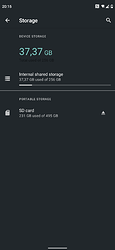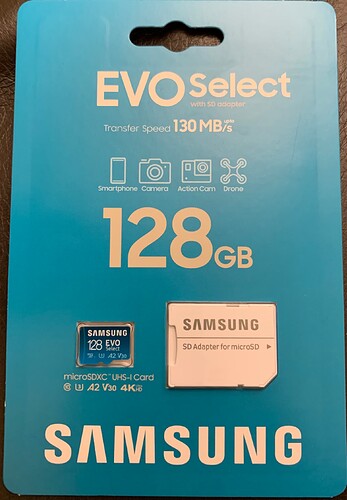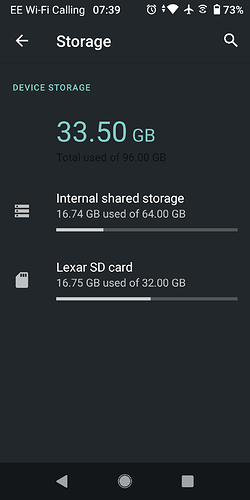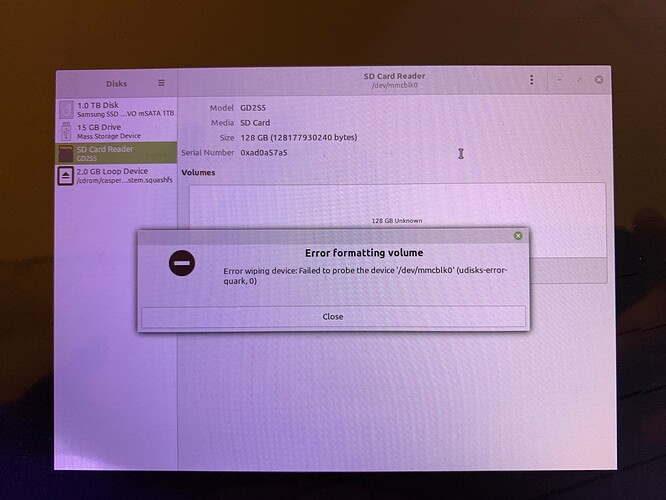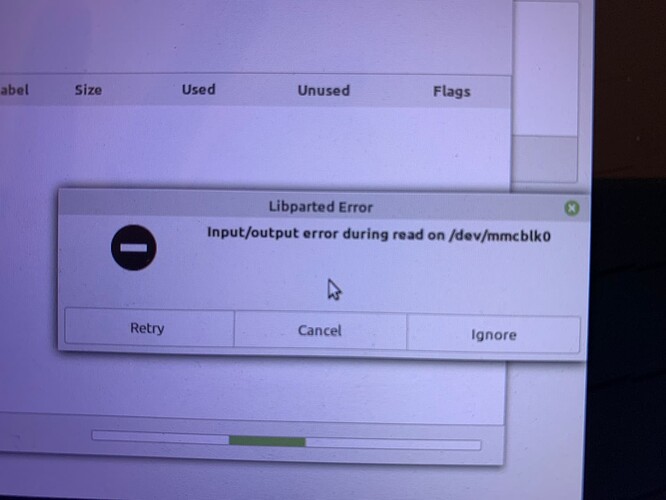I used the full size. I used GNOME Disks to format it. No special options enabled. I also don’t know if GPT is used or not. Will check in the near future. Because I prefer GPT.
I’m using a SanDisk Extreme 128 GB set up as external storage and it works like a charm.
Lucky me, I guess.
Update. The Samsung Select SD card has arrived.
H2Testw shows similar read speeds to the Sandisk Extreme (76 vs 77) and slightly slower write speeds (58 vs 67). Despite this, the FP4 is no longer complaining about slow performance, reinforcing the belief that this is a software issue. The card was immediately recognised and I was prompted to complete “setup”. I selected use as external this time and was again prompted to format (despite exFAT formatting at the factory). I did this and was invited to move applications to the drive…which was a little strange…When I declined I was told the card was ready to use.
When checking the card in storage settings it immediately shows 130GB of storage is consumed.
This is strange for a couple of reasons:
- I definitely selected portable storage rather than internal. The Android system files appear to have been automatically moved, yet this took no time.
- The system files when stored in on board storage, was much less than 130GB.
However, no further errors about the SD card and apps are performing as expected (with none running from the SD card). Again, this reinforces the belief that there is a known bug affecting specific card manufacturers which is not being advertised by FP. Still no response from FP Support.
Your screenshot shows a 256GB SDCard inserted but the above Photo shows a 128GB sdcard? Also it looks like the SD card shown as 256GB size is not formatted as external storage. IMHO your phone still thinks it has a previously installed 256GB card as internal storage attached…
I wouldn’t trust the storage settings. Your data may get corrupted!
Update: I can confirm the
256GB Samsung EVO Plus SD Card
microSDXC UHS-I Class(10) U3 4KUltra HD
is still working without any I/O problems.
BR, Toni
Yes it looks like internal storage Oops!
I have similar issues on FP3 using internal.
It doubles the size of the card and then takes 50% plus a bit away.
This is a test with a 16GB card
But it works fine as externsl with no capacity errors
Thanks @astx I’ve realised it was my error and I selected internal rather than portable storage when first formatting (I read it too quickly). IMHO the first/default option should be portable if there are known issues with internal.
Formatting the card as portable has resolved the issue with it seeing it as 256GB and showing the system files on there. However, I’m now stuck with the issue of the portable format option not actually working. It gets to 20% and says it is complete, but clearly it is not. When I look under storage it shows the card as unsupported:
I have tried resetting the SD card with “USB Image Tool v1.8.1.0”, but it’s still failing to format the card properly in the phone. A full exfat format in Windows (10) also fails. I don’t have another Android based phone to format it other than FP4. I have a Linux Mint machine, but only a VM, so unsure as to whether it can access the SD card to use GNOME Disks. I guess I could boot into Linux Mint from a USB drive and format the SD card from there, but it’s a bit of a risk that the wrong disk will be selected…I think I’ll use an old machine  what a PINTA just to use an SD card!
what a PINTA just to use an SD card!
I already tried formating two Sandisk SDs using different systems - without success. Seems to need an update of the kernel modul. Thanks Toni (@astx) a request ist in the way.
Spend your time on something else ![]()
Sorry, thanks to Zr4, who contacted the support concerning the SD Card problem.
I have as well a 256 Extrem Pro from SanDisk and it do not work. Or to say it stops working after reboot - after approximately 10-15 Minutes.
It works with an external SD card reader connected to the Fairphone.
What I recognize using the SD card reader: the Card gets really hot in the reader - that has a Aluminium surface and therefore is able to transmit the heat.
Previously in my HTC U12 - the card was in the Aluminium frame - good heat transmission as well.
Inside the Fairphone - there is no ability to transmit the heat.
So when the card becomes hot it stays hot inside.
That may explain on why the card stoped serving after approximately 10 Minutes of Use.
So my guess is: if the SD cards get hot and havin an issue with it - they will fail.
Alternatively: The internal card reader is not providing enough power when the card is in use.
I have a Samsung Evo in use and this one stays cool in operation and do not have any issue.
So I would not only blame Fairphone on this issue…  But maybe to position the SD as well into the Alu frame is not the worst idea for next design.
But maybe to position the SD as well into the Alu frame is not the worst idea for next design.
Hi @F.Sowa,
I’ve been proceeding on the assumption the Samsung disks will be OK (this is what I am using as of today). Having formatted the Samsung disk as internal earlier today, I can’t get it to reformat as portable and get past 20%. I have tried wiping the disk with all zeros and using a Linux Mint boot iso to format it with GNOME Disks. However, GNOME Disks gives me the following error:
I have read this is because the disk has no partition. I have tried creating a partition with GParted. However, I get this error:
When I boot off the main disk rather than a Linux Mint boot iso, I can format the SD card immediately with zero issues in Windows 10. I’m not as familiar with Linux, so I’m unsure what I’m doing wrong here. However, it’s a brand new disk (today) and given I can successfully format it in exactly the same machine/slot with a different OS, it doesn’t appear to be a hardware issue.
Any help on the Linux side gratefully appreciated.
Cheers,
Tim
Hi Tim,
using GParted first delete the existing partition, then create a new partition table with type msdos, then format this partition as exfat.
This should work…
This is a way that works in general, but I stick to this explanation here as this is the standard factory partition layout.
To reserve this layout not having to reformat with the Windows SD Card Association Formatting Tool I have some compressed empty Linux “dd” images for common sizes 8/16/32/64/128GB, which are very tiny if not actually keeping any data files.
Reformatting with any filesystem is possible (data space usually begins on partition 1), but the basic layout shouldn’t be changed unless it’s for some reason different like e.g. Raspberry Pie images.
Wow, didn’t know how complicated it could be to format an SD card. Thanks for that! I’ll give it another try with my SanDisk. Maybe it makes a difference.
@Patrick1: Would you mind sharing your images or giving a hint on what you changed in the linked script to make cards >32 GB work?
Did anybody try the SD Memory Card Formatter by Tuxera (see for example SD Memory Card Formatter | heise Download)? Could be a little easier, at least for Windows and Mac users.
Hi @F.Sowa,
Unfortunately it doesn’t. The card (still formatted with exFAT with windows and with a test,txt on it with some random data) still gives the libparted input/output error when I attempt to run gparted. In the bottom left hand corner of gparted, the status is confirming /dev/mmcblk0/
I have another identical Samsung card (for the other FP4) which is still in it’s packaging. I wonder if I could take an image of that card prior to formatting with the FP4 and use that to re-image the disk which gparted cannot read/the FP4 cannot format > 20% on portable format?
Thanks for your help.
Tim
Update. I tried the SD Card Association Formatting Tool linked from the site which @Patrick1 referenced. This is the same tool which @Zr4 asked about. I used the overwrite feature as opposed to a quick format. It made zero difference to the error I was seeing in gparted. However, having inserted it back into the FP4 and selecting portable, it immediately gave me the option to explore, rather than attempting to format it. I then opened the other Samsung disk package, put the disk into the Linux Mint booted machine and opened gparted…exactly the same error! Therefore, I don’t think it’s related to the FP4 formatting process. I’ve put the 2nd card into the 2nd FP4 and it’s also working fine  Happy New Year to you all!
Happy New Year to you all!
I’ll let let FP Support know when they finally come back to me that there are definite issues with the Sandisk cards. Samsung seem to be fine if you don’t mistakenly choose internal. They really need to remove the option for internal or properly fix the bugs.
Which is no general rule either. I once started with a Samsung Pro+ 128GB card in my FP2 which didn’t work reliable there. Replaced it with a Samsung Evo+ type same capacity which operates flawless since years.
Though it doesn’t work for my FP4. Swapped the card from my FP2 into the FP4 and it accepted it instantly and listed the stored data and could handle it. I anyway formatted it as external storage and it was wrecked completely thereby stopping at the mentioned 20% progress (which does as well on FP2 btw. but completes properly at last). GParted later showed there wasn’t even a partitioning left anymore. Purely blank.
A Verbatim Pro+ 32GB V30 U3 class 10 & Transcend 32GB V30 U3 class 10 worked fine in the FP4.
So this clearly looks like a problem to be solved that FP4 (with Android kernel 4.19.157-perf+ 1st oct 2021) does not handle/format all storage in a proper way.
@Zr4
In some cases I use “Panasonic-sdfv2000.exe” or the mentioned " SD Memory Card Formatter" if I don’t have a basic image for the card at hand.
I only went through this command line script procedure once but prefer to have it a bit more convenient.
Happy New Year to all! ![]()
So in some cases more patience maybe all that is missing
All the best
![]()
Which is no general rule either
Agreed. I was (uncharacteristically) generic in my statement. What I should have said is the only way to be certain is to test yourself.
However, this is time consuming. In the absence of a list of cards proven to work in the FP4 with the current release (which others have requested, and would save a lot of time messing about trialling and returning cards), I have found that the Samsung Evo Select 128GB (MB-ME128KA/EU) works out of the box for me in portable format (albeit with an I/O error when using GParted). The GParted issue does not impact the general use of the card in the FP4 as far as I can see so far (24 hours in).
Here is the link I used from Amazon if anyone wants the reference. I hope this saves someone else the time and hassle!
Happy New Year ![]()
Not really. At least for me, the formatting procedure claims to be finished after 20%. It feels a little like it just miscalculated the progress. So everything seems fine at once … well until you realize that it isn’t. Waiting any longer with the menu open won’t make much of a difference, I guess.
